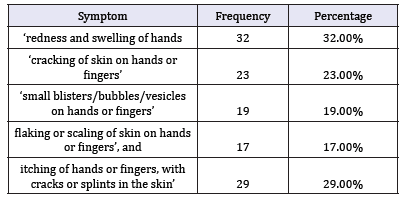- Submissions

Full Text
COJ Nursing & Healthcare
Skin Symptoms Among Bakery Workers: A Cross Sectional Survey
Mubashar Mashqoor Mir1 and Mohammad Sarwar Mir2*
1 Post Graduate Resident, Post Graduate Department of Dermatology, India
2 Senior Resident, Department of Hospital Adminstration, India
*Corresponding author: Mubashar Mashqoor Mir, Post Graduate Resident, Post graduate Department of Dermataology, GMC Jammu, India, Email:mohammedsarwarmir@gmail.com
Submission: May 02, 2018;Published: August 30, 2018

ISSN: 2577-2007Volume4 Issue1
Abstract
Background: Occupational skin disease is common and bakery workers are at increased risk of hand dermatitis. Aims: To explore the frequency of, and to identify risk factors for, skin symptoms in a small bakery. Methods: A cross-sectional survey of workers in a small bakery in Srinagar, using a questionnaire regarding skin symptoms over the last 12 months. Result: The overall response rate was 85% (40 women, 60 men). 60 percent of the workers reported one skin symptom.
Keywords: Bakery workers; Dermatitis; Occupational exposures
Introduction
Occupational skin disease is common [1]. UK Labour Force Survey estimates in 2007/2008 suggested that 16 000 people who had worked in the last 12 months had ‘skin problems’ caused or made worse by work [2]. Bakers and confectioners are at increased risk of hand dermatitis. A Swedish retrospective cohort study found that the relative risk of self-reported hand eczema for male bakers, as compared to population controls, was 3.5 (95% CI 2.8-4.5) and 2.8 (95% CI 2.2-3.6) for female bakers [3]. UK data from The Health and Occupation Reporting (THOR) network, based on reports to the EPIDERM surveillance scheme, suggest an estimated annual incidence of contact dermatitis among bakers and confectioners of 31.9 to 36/100 000 workers [4-6] and a previous UK survey found that 9% of bakers and flour mill workers had work-related skin symptoms [7]. The objective of the study was to identify the skin symptoms in bakers of third world as much of the work has been done in west.
Materials and Methods
A cross sectional survey of the workers works in different bakeries was carried out. Complete clinical examination followed by dermatological examination was carried out. The data was collected as per predesigned proforma.
The One or more of the five symptoms were noted:
A. ‘Redness and swelling of your hands or fingers’
B. ‘Cracking of skin on hands or fingers’
C. ‘Small blisters/bubbles/vesicles on hands or fingers’
D. ‘Flaking or scaling of skin on hands or fingers’, and
E. ‘Itching of hands or fingers, with cracks or splints in the skin’. The data was analyzed by descriptive statistics.
Result and Discussion
A total of 100 workers were analyzed of which at least 60 reported some dermatological symptom (Table 1). The main risk factors for occupational skin disease are prolonged wet work, work with irritants and atopy. Hand dermatitis among bakers can start early in training: one German cohort study 8 found 29% of apprentice bakers suffered from hand dermatitis within 6 months of commencing training. Poor knowledge of skin care may contribute to hand dermatitis among bakers and so educational interventions may be of benefit in this occupational group [8].
The primary predictors of interest to characterize the complexity of outpatient healthcare service use were
A. The number of outpatient health care providers consulted in the last 3 months and
B. The number of outpatient visits to a provider in the last 3 months.
This information was determined from survey responses. A composite “care complexity” variable capturing number of providers and number of visits was used to account for the overlap between the two indicators of complexity. The care complexity variable was collapsed into four categories: no visits to a provider in the past 3months, one visit to a single provider, two visits - each to a different provider, and multiple visits or providers.
Table 1:

References
- Steiner MFC (2011) Skin symptoms among bakery worker. Occupational Medicine 61: 280-282.
- HSE (2009) Self-reported work-related illness and workplace injuries in 2007/2008: results from the labour force survey. HSE Information Services, Caerphilly, UK.
- Brisman J, Meding B, Jarvholm B (1998) Occurrence of self-reported hand eczema in Swedish bakers. Occup Environ Med 55(11): 750-754.
- Skoet R, Olsen J, Mathiesen B, Iversen L, Johansen JD, et al. (2004) A survey of occupational hand eczema in Denmark. Contact Dermatitis 51(4): 159-166.
- Meyer JD, Chen Y, Holt DL Beck MH, Cherry NM (2000) Occupational contact dermatitis in the UK: A surveillance report from EPIDERM and OPRA. Occup Med (Lond) 50(4): 265-273.
- Turner S, Carder M, Van Tongeren M, McNamee R, Lines S, et al. (2007) The incidence of occupational skin disease as reported to the health and occupation reporting (THOR) network between 2002 and 2005. Br J Dermatol 157(4): 713-722.
- Cullinan P, Lowson D, Nieuwenhuijsen MJ, Sandiford C, Tee RD, et al. (1994) Work-related symptoms, sensitisation, and estimated exposure in workers not previously exposed to flour. Occup Environ Med 51(9): 579-583.
- Bauer A, Bartsch R, Hersmann C, Stadeler M, Kelterer D, et al. (2001) Occupational hand dermatitis in food industry apprentices: Results of a 3-year follow-up cohort study. Int Arch Occup Environ Health 74(6): 437-442.
© 2018 Mohammad Sarwar Mir. This is an open access article distributed under the terms of the Creative Commons Attribution License , which permits unrestricted use, distribution, and build upon your work non-commercially.
 a Creative Commons Attribution 4.0 International License. Based on a work at www.crimsonpublishers.com.
Best viewed in
a Creative Commons Attribution 4.0 International License. Based on a work at www.crimsonpublishers.com.
Best viewed in 







.jpg)






























 Editorial Board Registrations
Editorial Board Registrations Submit your Article
Submit your Article Refer a Friend
Refer a Friend Advertise With Us
Advertise With Us
.jpg)






.jpg)














.bmp)
.jpg)
.png)
.jpg)










.jpg)






.png)

.png)



.png)






